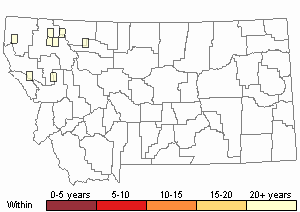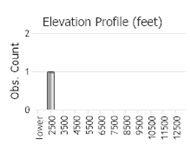View in other NatureServe Network Field Guides
NatureServe
Montana
Utah
Wyoming
Idaho
Wisconsin
British Columbia
South Carolina
Yukon
California
New York
An Extinguisher Moss - Encalypta affinis
General Description
Plants: Acrocarpous, growing in loose to somewhat crowded clumps of upright shoots. Stems 1-2.5 cm tall, branching freely (FNA 2007) or simple (Lawton 1971), without a central strand (FNA 2007).
Leaves: Bent, twisted or curled when dry, spreading when moist, 3.5-5.5 mm in length, shaped like a spatula (Lawton 1971), strap, or lance, narrowing to a nearly obtuse or curved leaf tip with a smooth hyaline awn; leaf edges smooth, erratically curved back and downward, occasionally flat; costa extending to, beyond, or not quite reaching the apex (FNA 2007).
Leaf Cells: Lower laminal cells long and quadrangular with fine walls, papillose; upper laminal cells nearly square, papillose (FNA 2007); papillae of upper and medial cells simple or 2- to 4-lobed, on juvenile leaves sometimes faint (Lawton 1971); lower marginal cells not distinct from adjacent cells (FNA 2007).
Diagnostic Characteristics
No other species of the genus has basal leaf cells displaying papillae (FNA 2007).
Range Comments
AK to NT, s to WA and MT (FNA 2007). Known in Montana from Flathead, Glacier, Lincoln, and Missoula Counties (Elliott & Pipp, 2016).
Observations in Montana Natural Heritage Program Database
Number of Observations: 9
(Click on the following maps and charts to see full sized version)
Map Help and Descriptions
Relative Density

Recency



 (Observations spanning multiple months or years are excluded from time charts)
(Observations spanning multiple months or years are excluded from time charts)
Habitat
On soil or stone, in sheltered montane and alpine areas (FNA 2007), an arctic-alpine species (Steere 1973).
Reproductive Characteristics
Autoicous. Perigonial bracts shorter than the vegetative leaves (Lawton 1971). Seta deep red, 6-19 mm tall. Capsule ochre, 3-4 mm in length, typically borne beyond the bracts, occasionally only partially emerged (FNA 2007), smooth, the neck creased when dry; operculum 1.6-2 mm in length (Lawton 1971); peristome with 16 papillose and very slender lance-shaped teeth; endostome joined to and nearly the length of the teeth, papillose. Calyptra papillose in the upper half (FNA 2007), occasionally with fine papillae in the bottom half (Lawton 1971), 5-7 mm tall, the bottom edge appearing deeply torn (FNA 2007).
Stewardship Responsibility
References
- Literature Cited AboveLegend:
 View Online Publication
View Online Publication Elliott, J.C. and A.K. Pipp. 2018. A Checklist of Montana Mosses (1880-2018). Updated 3 January, 2020. Montana Natural Heritage Program, Helena, Montana. 73 pp.
Elliott, J.C. and A.K. Pipp. 2018. A Checklist of Montana Mosses (1880-2018). Updated 3 January, 2020. Montana Natural Heritage Program, Helena, Montana. 73 pp. Flora of North America Editorial Committee, eds. 2007. Flora of North America North of Mexico. Volume 27. Bryophytes: Mosses, Part 1. Oxford University Press, Inc., NY. xxi + 713 pp.
Flora of North America Editorial Committee, eds. 2007. Flora of North America North of Mexico. Volume 27. Bryophytes: Mosses, Part 1. Oxford University Press, Inc., NY. xxi + 713 pp. Steere, William. 1978. The Mosses of Arctic Alaska. J. Cramer, Liechenstein.
Steere, William. 1978. The Mosses of Arctic Alaska. J. Cramer, Liechenstein.
- Additional ReferencesLegend:
 View Online Publication
View Online Publication
Do you know of a citation we're missing? Elliot, J. C. 1993. Second checklist of Montana mosses. Unpublished report. U.S. Forest Service, Region 1. Missoula, MT. 45 pp.
Elliot, J. C. 1993. Second checklist of Montana mosses. Unpublished report. U.S. Forest Service, Region 1. Missoula, MT. 45 pp. Lawton, E. 1971. Keys for the Identification of the Mosses on the Pacific Northwest. Reprinted from 'Moss Flora of the Pacific Northwest'. Published as Supplement No. 2 of the Journal of the Hattori Botanical Laboratory. Nichinan, Miyazaki, Japan. 66 pp.
Lawton, E. 1971. Keys for the Identification of the Mosses on the Pacific Northwest. Reprinted from 'Moss Flora of the Pacific Northwest'. Published as Supplement No. 2 of the Journal of the Hattori Botanical Laboratory. Nichinan, Miyazaki, Japan. 66 pp. Lawton, E. 1971. Moss Flora of the Pacific Northwest. Hattori Botanical Laboratory. Japan: Yamabuki-cho, Shinjuku-ku, Tokyo. 362 pages plus appendices.
Lawton, E. 1971. Moss Flora of the Pacific Northwest. Hattori Botanical Laboratory. Japan: Yamabuki-cho, Shinjuku-ku, Tokyo. 362 pages plus appendices.
- Web Search Engines for Articles on "An Extinguisher Moss"





